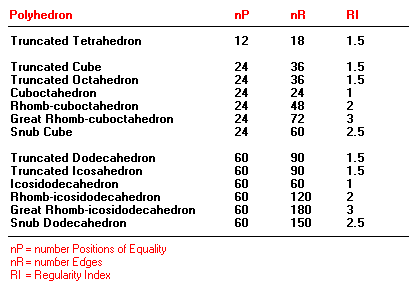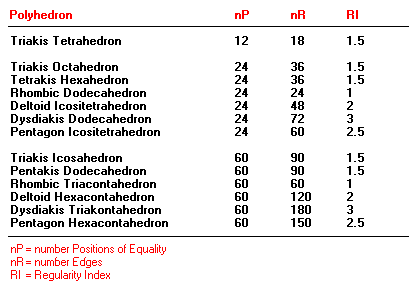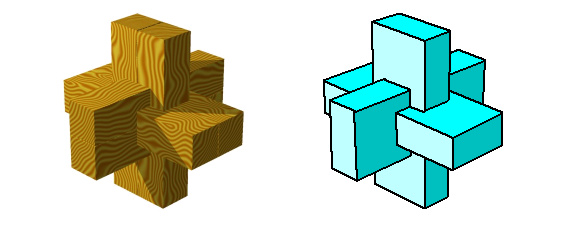First I would like to demonstrate
the use of the regularity index in the half-regular polyhedra: the Archimedic
and Catalan Solids. The number of positions of equality is quite easy
to determine. These are equal to the corresponding Platonic solid. For
example, a truncated tetrahedron has twelve positions of equality,
while a truncated cube or octahedron has 24 .
The number of edges of an
Archimedic or Catalan polyhedron is however variable, therefore are
not al regularity indexes the same (although they are all
'half-regular polyhedra'). In the table below a summary is given off
the different Archimedic solids with their corresponding regularity
indexes.

The value of the regularity index
is between 1 and 3 in Archimedic solids. This means that not all
Archimedic polyhedra do have the same regularity. The regularity index
is thus much more precise in determining how regular a polyhedron is
than the five rules described before. Remarkable is that truncating a
polyhedron will increase the regularity index threefold (In fact a
great rhomb-cuboctahedron is a truncated version of the cuboctahdron,
and this observation applies also to these solids).
The Catalan polyhedra are the
dual counterparts of the Archimedic solids. You can expect that
the regularity index is the same as in the Archimedic polyhedra.
You can check by yourself that this is correct. In the table below
a summary regarding the regularity index in Catalan solids is
given.

If you calculate the
regularity index of other (half-regular) polyhedra, than you can
find out that the RI in prisms is 1.5, in anti-prisms 2, in double
pyramids 1.5 and in trapezoids 2.
Below another example for
calculating the regularity index. All three polyhedra do have 12
edges. All three polyhedra aplies to at least three of the five
rules of regularity (solids are convex, vertexes are congruent and
dihedral angles are congruent). The first polyhedron is a cube
with a regularity index of 0.5. The second solid has 8 positions
of equality and therefore a regularity index of 1.5. The last
polyhedron has a regularity index of 3, because the number of
positions of equality is only 4.

It is possible to calculate
the regularity index of non-convex polyhedra. It will be shown
that the regularity index of Kepler-Poinsot polyhedra is 0.5, just
like the Platonic solids. Also puzzles, which are often non-convex
in shape, do have a regularity index. For example the Chinese
Cross Puzzle. This puzzle can be seen as a compound of three
square beams. In total this 'polyhedron' has 36 edges. The number
of positions of equality is 12. De regularity index of a Chinese
Cross Puzzle is 3 and could therefore been seen as
'half-regular'.

The last example is the
rhomb-deltoid-pentacontahectahedron already mentioned at the 'five
rules' of regularity. This polyhedron has 300 edges. The number of
equality is 60 (so quite high). De regularity index is 5. So not very
more irregular than for instance Archimedic polyhedra....